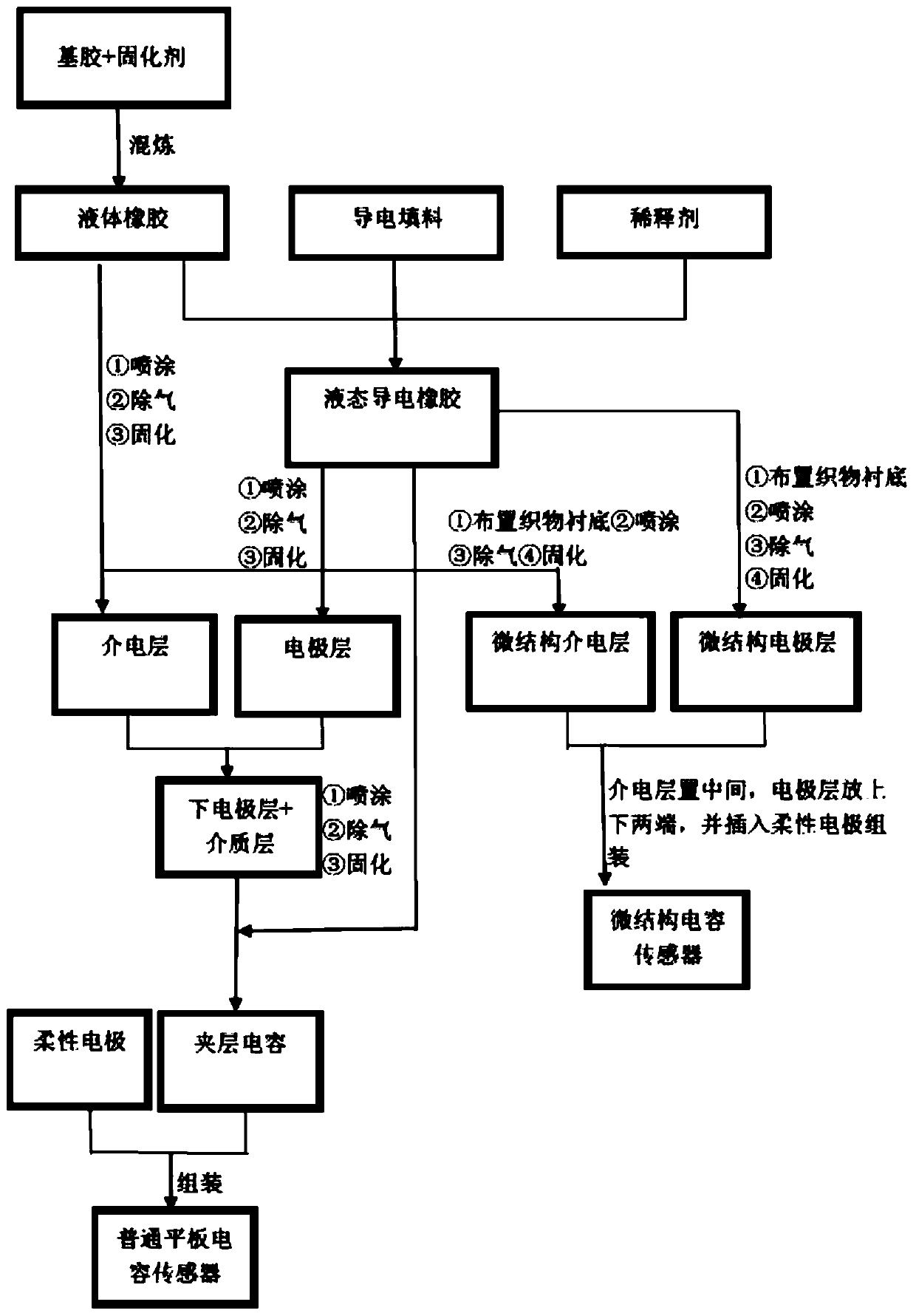Flexible capacitive sensor based on conductive rubber
A capacitive sensor, conductive rubber technology, applied in instruments, measuring devices, measuring forces, etc., can solve problems such as difficulty in evaluating performance, complex processes, and cumbersome processes, and achieve good process integrity, safe preparation conditions, and sample extension. high rate effect
- Summary
- Abstract
- Description
- Claims
- Application Information
AI Technical Summary
Problems solved by technology
Method used
Image
Examples
example 1
[0053] The liquid pure rubber formula is mixed with 80wt% PDMS and 20wt% Dow Corning 184B curing agent. The viscosity of the liquid pure rubber after mixing is 1100mPa s; the liquid conductive rubber formula is 60wt% PDMS, 10wt% Dow Corning 184B curing agent, and 20wt% nickel-coated carbon fiber filler (The length of the nickel-coated carbon fiber is 110 μm, and the diameter is 12 μm) is mixed with 10 wt % simethicone diluent, and the viscosity of the liquid conductive rubber after mixing is 1000 mPa·s. The preparation is carried out according to the following steps: ① Preparation of the first electrode layer, put the liquid conductive rubber into the spray gun, spray it on the PET film at a pressure of 0.7MPa, and further perform vacuum degassing under the environment of -0.1MPa for 10min, and finally place it at 150°C 5min curing and forming; ②dielectric layer preparation, put pure liquid rubber into the spray gun, and spray it on the first electrode layer prepared in ① under...
example 2
[0056] The liquid pure rubber formula is mixed with 90wt% PDMS and 10wt% Dow Corning 184B curing agent; the viscosity of the liquid pure rubber after mixing is 1300mPa s; the liquid conductive rubber formula is 40wt% PDMS, 10wt% Dow Corning 184B curing agent, and 30wt% nickel-coated carbon fiber filler (Nickel-coated carbon fiber with a length of 95 μm and a diameter of 10 μm) is mixed with 20 wt % simethicone diluent, and the viscosity of the liquid conductive rubber after mixing is 1080 mPa·s. Preparation is carried out according to the following steps: ① Preparation of the first electrode layer, put the liquid conductive rubber into the spray gun, spray it on the PET film at a pressure of 0.7MPa, and further perform vacuum degassing under the environment of -0.1MPa for 10min, and finally place it at 150°C 5min curing and forming; ②dielectric layer preparation, put pure liquid rubber into the spray gun, and spray it on the first electrode layer prepared in ① under the pressur...
example 3
[0059] The liquid pure rubber formula is 85wt% PDMS, mixed with 15wt% Dow Corning 184B curing agent. Filler (nickel-coated carbon fiber with a length of 130 μm and a diameter of 17 μm) was mixed with 15 wt % simethicone diluent, and the viscosity of the liquid conductive rubber after mixing was 900 mPa·s. The preparation was carried out according to the following steps: ① Arrange two hydrophobic cloth substrates with microstructures on the surface. The surface of the hydrophobic cloth has a fibrous knot-like texture, the width of the fibrous knots is 100 μm, and the height of the knots is 15 μm. ② Spray the electrode layer, put the liquid conductive rubber into the spray gun, spray it on the first substrate under the pressure of 0.7MPa, carry out vacuum degassing at -0.1MPa for 10min, and further, place it at 150℃ for 7min Curing; ③Spray the dielectric layer, put the liquid pure rubber into the spray gun, spray it on the second substrate under the pressure of 0.7MPa, carry out...
PUM
| Property | Measurement | Unit |
|---|---|---|
| Length | aaaaa | aaaaa |
| Total thickness | aaaaa | aaaaa |
| Length | aaaaa | aaaaa |
Abstract
Description
Claims
Application Information
 Login to View More
Login to View More - R&D
- Intellectual Property
- Life Sciences
- Materials
- Tech Scout
- Unparalleled Data Quality
- Higher Quality Content
- 60% Fewer Hallucinations
Browse by: Latest US Patents, China's latest patents, Technical Efficacy Thesaurus, Application Domain, Technology Topic, Popular Technical Reports.
© 2025 PatSnap. All rights reserved.Legal|Privacy policy|Modern Slavery Act Transparency Statement|Sitemap|About US| Contact US: help@patsnap.com



